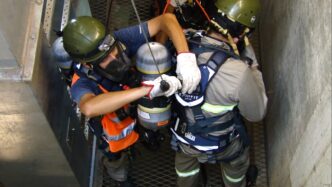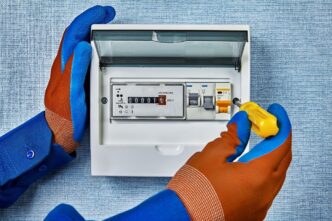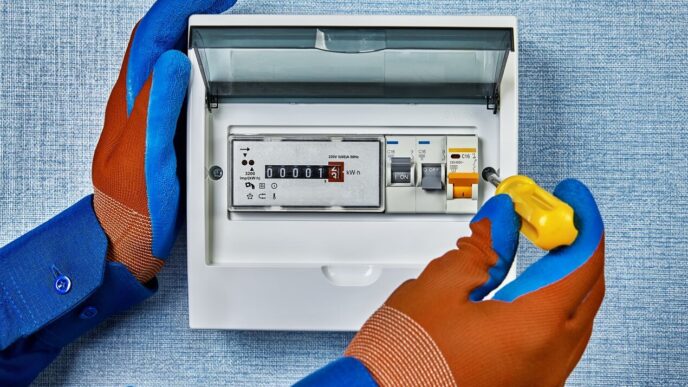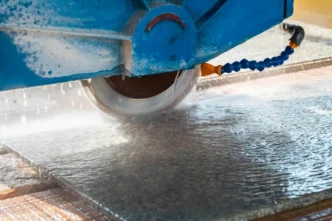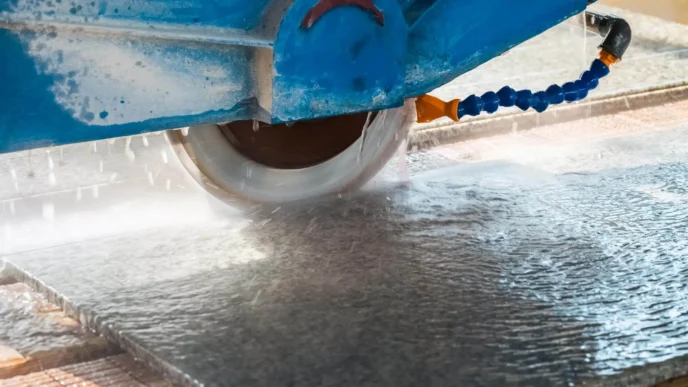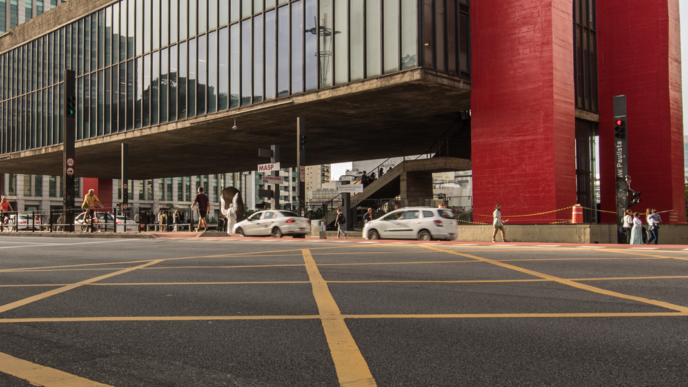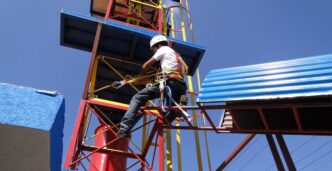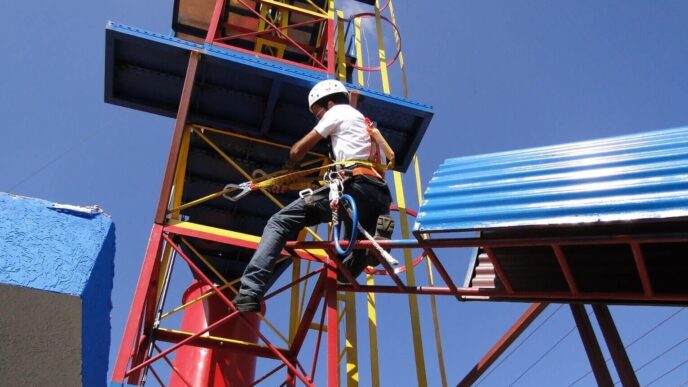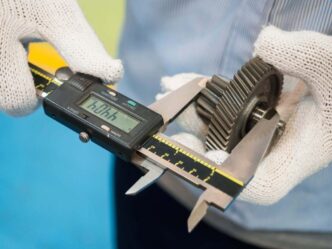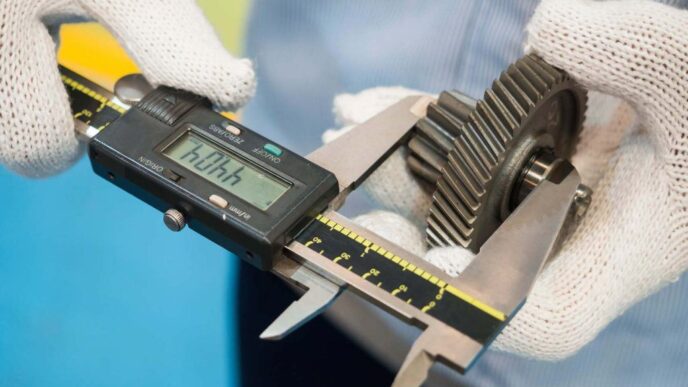Nome Técnico: Training Course NR 33 Safety and Health in Confined Space Works Entry Supervisor Level
Referência: 10802
We provide courses and training; We carry out Translations and Interpretations in Technical Language: Portuguese, English, Spanish, Mandarin, German, Hindi, Japanese, Arabic and others consult
NR 33 Confined Space Entry Supervisor Training
Entry Supervisor: person able to operate the entry permit with responsibility to complete and sign the Entry and Work Permit (PET) for the development of entry and safe work inside confined spaces.
Objective: NR 33 Confined Space Entry Supervisor Training professionals who already have proven proficiency in the subject to act as a Confined Space Entry Supervisor as recommended by NR 33, paragraph 33.3.5.4 and its updates.
OUR DIFFERENTIAL:
(a) The Instructors are Engineers who master the Technical languages in Portuguese, German and English, Mandarin, Spanish, among others with international know-how and active Passports.
We do not work with interpreters, as they are matters of technical engineering levels, their version, interpretation and translation without engineering training can be harmed, inducing serious misunderstandings.
(b) All Professionals have mandatory Occupational Safety Training NR 10, NR 35, NR 33, NR 12, among others, updated and valid.
(c) Upon completion, certificates of participation and achievement will be issued, signed with electronic digital signatures by legally qualified professionals with active CREA:
Work Safety Engineer (Technical Responsible) with active CREA /ART;
Engineer. Electric/Sec. Work (Instructor) with active CREA /ART;
Occupational Physician with active CRM;
Technical Instructor for Fire Fighting, First Aid and Chemical Emergencies;
Click on the Link:Criteria for Issuing Certificates as per the Standards
Treinamento Livre Profissionalizante Noções Básicas (Não substitui Formação Acadêmica ou Ensino Técnico)Certificado de conclusão
Conteúdo Programático
NR 33 Confined Space Entry Supervisor Training
Identification of confined spaces;
Criteria for indicating and using equipment for risk control;
Knowledge of safe practices in confined spaces;
Occupational safety and health legislation;
Respiratory protection program;
Classified area;
Rescue operations;
Emission of the Entry and Work Permit (PET);
Execution of tests, equipment conference and the procedures contained in the Entry and Work Permission;
Ensure that emergency and rescue services are available and that the means to operate them are operative;
Cancel entry and work procedures when necessary;
Terminate the Entry and Work Permission after the end of services.
Awareness of Importance:
Operating Instruction Manual for the Machine or Equipment;
Inspection and Maintenance Plan for the Machine or Equipment according to NR 12;
Technical Report with ART of the Machine or Equipment according to NR 12;
Load Test (with ART) according to NR 12;
END (Non-Destructive Testing) according to NR 12;
Electrical Tests NR 10;
Tagging of Machines and Equipment;
RETROFIT – Modernization Process;
Daily Checklist;
One-off or cyclical maintenance.
Activity Complements:
Awareness of Importance:
APR (Preliminary Risk Analysis);
PAE (Emergency Action Plan;
PGR (Risk Management Plan);
Understanding the need for the Rescue Team;
The importance of knowledge of the task;
Prevention of accidents and notions of first aid;
Fire protection;
Perception of risks and factors that affect people’s perceptions;
Impact and behavioral factors on safety;
Fear factor;
How to discover the fastest and easiest way to develop Skills;
How to control the mind while working;
How to manage and manage working time;
Why balance energy during activity in order to obtain productivity;
Consequences of Risk Habituation;
Causes of accidents at work;
Notions about Tree of Causes;
Understanding Fault Tree;
Understandings on Ergonomics;
Workstation Analysis;
Ergonomic Risks;
Hazard Communication Standard (HCS) – OSHA;
Practical Exercises:
Record of Evidence;
Theoretical and Practical Evaluation;
Certificate of participation.
NOTE:
We emphasize that the General Program Content of the Course or Training may be changed, updated, adding or deleting items as necessary by our Multidisciplinary Team.
Our Multidisciplinary Team is allowed to update, adapt, change and/or exclude items, as well as the insertion or exclusion of Rules, Laws, Decrees or technical parameters that they deem applicable, whether related or not, with the Contracting Party being responsible for carrying out the necessary services pursuant to the relevant legislation.
NR 33 Confined Space Entry Supervisor Training
Conteúdo Programático Normativo
NR 33 Confined Space Entry Supervisor Training
Identification of confined spaces;
Criteria for indicating and using equipment for risk control;
Knowledge of safe practices in confined spaces;
Occupational safety and health legislation;
Respiratory protection program;
Classified area;
Rescue operations;
Emission of the Entry and Work Permit (PET);
Execution of tests, equipment conference and the procedures contained in the Entry and Work Permission;
Ensure that emergency and rescue services are available and that the means to operate them are operative;
Cancel entry and work procedures when necessary;
Terminate the Entry and Work Permission after the end of services.
Awareness of Importance:
Operating Instruction Manual for the Machine or Equipment;
Inspection and Maintenance Plan for the Machine or Equipment according to NR 12;
Technical Report with ART of the Machine or Equipment according to NR 12;
Load Test (with ART) according to NR 12;
END (Non-Destructive Testing) according to NR 12;
Electrical Tests NR 10;
Tagging of Machines and Equipment;
RETROFIT – Modernization Process;
Daily Checklist;
One-off or cyclical maintenance.
Activity Complements:
Awareness of Importance:
APR (Preliminary Risk Analysis);
PAE (Emergency Action Plan;
PGR (Risk Management Plan);
Understanding the need for the Rescue Team;
The importance of knowledge of the task;
Prevention of accidents and notions of first aid;
Fire protection;
Perception of risks and factors that affect people’s perceptions;
Impact and behavioral factors on safety;
Fear factor;
How to discover the fastest and easiest way to develop Skills;
How to control the mind while working;
How to manage and manage working time;
Why balance energy during activity in order to obtain productivity;
Consequences of Risk Habituation;
Causes of accidents at work;
Notions about Tree of Causes;
Understanding Fault Tree;
Understandings on Ergonomics;
Workstation Analysis;
Ergonomic Risks;
Hazard Communication Standard (HCS) – OSHA;
Practical Exercises:
Record of Evidence;
Theoretical and Practical Evaluation;
Certificate of participation.
NOTE:
We emphasize that the General Program Content of the Course or Training may be changed, updated, adding or deleting items as necessary by our Multidisciplinary Team.
Our Multidisciplinary Team is allowed to update, adapt, change and/or exclude items, as well as the insertion or exclusion of Rules, Laws, Decrees or technical parameters that they deem applicable, whether related or not, with the Contracting Party being responsible for carrying out the necessary services pursuant to the relevant legislation.
NR 33 Confined Space Entry Supervisor Training
Carga Horária
NR 33 Confined Space Entry Supervisor Training
Participants without experience:
Minimum working load = 80 hours / class
Participants with experience (Authorized and Watcher Level):
Minimum working load = 16 hours / class
Participants with experience (Entry Supervisor Level):
Minimum working load = 40 hours / class
Update (Recycle – Authorized and Watcher Level):
Minimum working load = 08 hours / class
Update (Recycle – Entry Supervisor Level):
Minimum working load = 16 hours / class
Update (Recycle): NR-33 Item 33.3.5.3: All authorized workers, Watchers and Entry Supervisors must receive periodic training every 12 months, with a minimum working load of 8 hours. (Amended by Ministerial Order No. 1,409, of August 29, 2012).
NR-33 Item 3.5.2: The employer shall develop and implement training programs whenever any of the following situations occur:
a) change in procedures, conditions or work operations;
b) some event that indicates the need for new training; and
(c) where there is a reason to believe that there are deviations in use or entry procedures in confined spaces or that knowledge is inadequate.
NR 18.14.2.1 Operators must have completed elementary education and must receive qualification and specific training on the equipment, with a minimum workload of sixteen hours and an annual update with a minimum workload of four hours.
NR 33 Confined Space Entry Supervisor Training
Referências Normativas
NR 33 Confined Space Entry Supervisor Training
Referências Normativas quando for o caso aos dispositivos aplicáveis e suas atualizações:
NR 01 – Disposições Gerais;
NR 06 – Equipamento de Proteção Individual – EPI;
NR 15 – Atividades e Operações Insalubres;
NR 16 – Atividades e Operações Perigosas;
NR 17 – Ergonomia;
NR 33 – Segurança e Saúde nos Trabalhos em Espaços Confinados;
ABNT NBR 16577 – Espaço confinado – Prevenção de acidentes, procedimentos e medidas de proteção;
ABNT NBR 14606 – Armazenamento de líquidos inflamáveis e combustíveis — Entrada em espaço confinado em tanques subterrâneos e em tanques de superfície;
ABNT NBR ISO/CIE 8995 – Iluminação de ambientes de trabalho;
Protocolo 2015 Guidelines American Heart Association;
Portaria GM N.2048 – Política Nacional de Atenção as Urgências;
ISO 45001 – Sistemas de gestão de saúde e segurança ocupacional – Requisitos com orientação para uso.
Nota: Este Serviço atende exclusivamente as exigências da Secretaria Especial de Previdência e Trabalho (SEPRT); quando se tratar de atendimento a outros Órgãos, informe no ato da solicitação.
NR 33 Confined Space Entry Supervisor Training
Complementos
NR 33 Confined Space Entry Supervisor Training
Attention: The Course teaches you to apply the normative concepts of the standard, which enables you to sign Projects, Reports, Expertise etc. are the duties that the Legally Qualified Professional has with his Class Council, for example, CREA.
This course aims to study situations where it will be necessary to apply: Concepts and Calculations according to the relevant Norms and does not replace the analysis and responsibility on the part of each professional accredited with CREA or other Class Councils in the most varied situations, where makes it absolutely necessary to respect the conditions of conservation of the equipment, periodic checking of the instruments, as well as the respect of primary capacity pre-determined by the manufacturers of PPE’s, among others based on the corresponding Norms.
Certificate: The Certificate will be issued to each participant who achieves a minimum of 70% (theoretical and practical) in accordance with the Regulatory Standards.
Criteria of Training or Update Certificates:
Our certificates are numbered and issued in accordance with the Regulatory Standards and applicable devices:
Issuance of A.R.T. (Annotation of Technical Responsibility);
Employee’s full name and identity document;
Program content;
Workload; City, place and date of the training;
Name, identification, signature and qualification of the instructor (s);
Name, identification and signature of the technician responsible for the training;
Name and qualification of our Qualified Professional;
Specification of the type of work;
Space for signature of the trainee;
Information on the Certificate that the participants received an e-book containing didactic material (Handout, Videos, Standards, etc.) presented in the training.
Training Evidence: Edited video, photos, digitalized documentation, continuous improvement, instructor’s opinion: Consult values.
Heads up:
Distance Learning, Distance Learning, Distance Learning The Distance Learning Certificate also known as Online, according to LAW No. 9,394, OF DECEMBER 20, 1996. It can be used for: Complementary Activities; Company valuations; Public tenders; University Extension; Extracurricular hours; Improved chances of getting a job; Recruitment processes; Internal promotions; Title Evidence; Doctoral selections; Master’s selections; You get other opportunities. Course 100% EAD (Distance Learning) or Semi-face-to-face needs a Pedagogical Project is only valid for the Employer, if it follows in full the SEPRT Ordinance No. 915, of July 30, 2019 – NR 01 – General Provisions of the Special Secretariat of Social Security and Labor. Click hereClique aqui
Understand the relationship between Price and Value:
Performing a task as strategic as pricing a Service requires knowledge of the business world.
Two fundamental concepts to understand how to price are the definitions of Price and Value.
Value is a qualitative concept, and it is linked to the transformative potential of that content.
A course is more valuable when it adds more knowledge to the target audience.
Price is a consequence of value.
Because it is an essentially quantitative concept, it is responsible for “translating” the value into a number.
Therefore, the greater the value added to the content, the higher the fair price.
Causes of Work Accidents:
Lack of alert by the employer;
Lack of employee care;
Even carrying out all the mandatory Training and Reports on Occupational Health and Safety in the event of an accident at work, the employer will be subject to Processes such as:
Police Inquiry – Civil Police;
Expertise through the Criminalist Institute;
Verification procedure with the Regional Labor Office;
Public Civil Inquiry before the Public Ministry of Labor to verify that the other workers are not in danger;
The INSS will question the cause of the accident that could be avoided and refuse to pay the benefit to the employee;
Family members may file a lawsuit in the Labor Court claiming moral, material, dislocation damages, etc .;
Procedural Tsunami forcing the Employer to generate Defense Strategy even if he is right;
Although the Labor Delegation Law does not provide that “guilt en vigilando” applies, but only the responsibility of delivering the equipment, however it is worth stressing that the Employer is also responsible for monitoring;
When an accident occurs in addition to destroying all the “good humor” in the relationships between employees or also the very serious problem of defending yourself from a series of procedures at the same time, then it is worth investing in this prevention;
The Employee cannot carry out activities exposed to risks that could compromise his safety and health, so the Employer will be able to respond in the criminal and civil spheres.
LAW No. 5,194, OF DEC 24, 1966 – CONFEA:
“Section III
Illegal Exercise of Profession
Art. 6 – Illegally practice the profession of engineer, architect or agronomist:
a) the natural or legal person who performs acts or provides services, public or private, reserved for the professionals referred to in this Law and who does not have registration with the Regional Councils:
b) the professional who carries out activities that are foreign to the attributions described in his record;
c) the professional who lends his name to people, firms, organizations or companies executing works and services without his real participation in their work;
d) the professional who, suspended from his practice, continues to work;
e) the firm, organization or company that, as a legal entity, performs duties reserved for professionals in Engineering, Architecture and Agronomy, in violation of the provisions of the sole paragraph of Article 8 of this Law. ”
NR 33 Confined Space Entry Supervisor Training
Saiba Mais
Know more: NR 33 Confined Space Entry Supervisor Training:
Curso Espaço Confinado Supervisores NR 33 em Inglês:
33.3.5.3 All Authorized Workers, Watchers and Entry Supervisors must receive periodic training every 12 months, with a minimum workload of 8 hours. (Amended by Ministerial Order No. 1,409, from August 29th, 2012).
33.3.5.2 The employer shall develop and implement training programs whenever any of the following situations occur:
A) change in procedures, conditions or work operations;
B) some event that indicates the need for new training; and
(C) where there is a reason to believe that there are deviations in use or entry procedures in confined spaces or that knowledge is not adequate.
NR 33 Confined Space Entry Supervisor Training. Contact us.
33.2.2 Workers shall:
A) collaborate with the company in the fulfillment of this NR;
B) use properly the means and equipment supplied by the company;
C) communicate to the Watcher and Entry Supervisor the situations of risk for their safety and health or third parties, which they are aware; and
D) comply with the procedures and guidelines received in the training regarding confined spaces.
33.3.4.5 The Entry Supervisor shall perform the following functions:
A) issue the Entry and Work Permission prior to the start of activities;
B) perform tests, check the equipment and procedures contained in the Entry and Work Permit;
C) ensure that emergency and rescue services are available and that the means of operating them are operational;
D) cancel entry and work procedures when necessary; and
E) terminate the Entry and Work Permission after the end of services.
33.3.4.6 The Entry Supervisor may perform the Watcher function.
33.3.4.7 The Watcher shall perform the following functions:
A) continuously maintain accurate counting of the number of authorized workers in the confined space and ensure that all leave at the end of the activity;
B) stay out of confined space, near the entrance, in permanent contact with authorized workers;
C) adopt emergency procedures, triggering the rescue team, public or private, when necessary;
D) operate the people movers; and
E) order the abandonment of the confined space whenever it recognizes any sign of alarm, danger, symptom, complaint, prohibited condition, accident, unforeseen situation or when it cannot effectively perform its tasks, nor be replaced by another Watcher.
33.3.4.8 Watcher will not be able to perform other tasks that could compromise the main duty that is to monitor and protect the authorized workers;
33.3.4.9 It is the responsibility of the employer to provide and ensure that all workers entering confined spaces have all the equipment for risk control, foreseen in the Entry and Work Permit.
33.3.4.10 In the event of an Immediately Dangerous Atmosphere to Life or Health – IPVS Atmosphere -, the confined space may only be entered with the use of an autonomous demand mask with positive pressure or compressed air line ventilator with auxiliary cylinder for escape.
33.3.5.3 All authorized workers, Watchers and Entry Supervisors must receive periodic training every 12 months, with a minimum workload of 8 hours. (Amended by Ministerial Order No. 1,409, from August 29th, 2012).
Curso Espaço Confinado Supervisores NR 33 em Inglês:
33.3.5.5 The training of Entry Supervisors must be performed within working hours, with programmatic content established in sub-item 33.3.5.4, plus:
A) identification of confined spaces;
B) criteria for indication and use of risk control equipment;
C) knowledge of safe practices in confined spaces;
D) labor safety and health legislation;
E) respiratory protection program;
F) classified area; and
G) rescue operations.
33.3.5.6 All Entry Supervisors must receive specific training, with a minimum workload of 40 hours for initial training. (Amended by Ministerial Order No. 1,409, from August 29th, 2012).
33.3.5.7 The instructors designated by the technical leader shall have proven proficiency in the subject.
33.3.5.8 At the end of the training, a certificate containing the worker’s name, program content, workload, specification of work type and confined space, date and location of the training, with the signatures of the instructors and the technical manager.
33.3.5.8.1 A copy of the certificate must be delivered to the employee and the other copy must be filed with the company.
Curso Espaço Confinado Supervisores NR 33 em Inglês: Consulte-nos.Curso Espaço Confinado Supervisores NR 33 em Inglês:
Practical Exercises;
Perception Risk and Facts inflicted on people;
Safety Impact and Behavior Facts;
Fear Fact;
Risk Habituation and Consequences;
The matter and knowledge of task;
Knowledge of Ergonomic;
Work Station Analysis;
Ergonomics Risk;
Final Test Teory and Practical;
Participation Certification;
All persons who may be required to work in or otherwise enter a confined space are at risk from any hazards that may be present. These include, but are not limited to:
• Members of the ship’s company who may be required to enter a confined space for the purposes of maintenance or for any other purpose.
• Shorebased company personnel who may be aboard ship
• Cargo surveyors
• Class society surveyors
• Port State Control inspectors
• Third party contractors, such as welders and fumigators
• Lawenforcement personnel who may board the ship and require access to confined spaces
• Maritime casualty investigators
• Stevedores and other dockworkers.
• Technical personal assigned as consultants on a temporary basis.
Do not assume that persons boarding the vessel who require access to confined spaces have been properly trained, are competent to enter a confined space, are aware of the hazards or the means necessary to mitigate the hazards.
All persons who require to make entry to a confined space must only be permitted to do so under the supervision of a competent person assigned to do so, who is a member of the ship’s company and follow shipboard procedures and precautions.
Under no circumstances should a person who is not a member of the ship’s company be permitted to move around the vessel alone and unaccompanied by a member of the ship’s crew.
If you are not a member of the ship’s crew ensure that you are accompanied by a competent crewmember at all times and that you have, and are familiar with, any necessary documents, such as relevant Material Safety Data Sheets, and permits, that are required.
When you enter a confined space it is your responsibility, and your duty towards others on board, to ensure that it is as safe as reasonably practicable to do so and that you are aware of the hazards involved.
NR 33 Confined Space Entry Supervisor Training: Consult us.
Validade
Substituir:
Validade das Inspeções: ANUAL exceto se ocorrer quaisquer das seguintes situações:
a) mudança nos procedimentos, finalidades, condições ou operações de trabalho;
b) evento que indique a necessidade de nova Inspeção;
c) mudança de empresa;
d) troca de máquina ou equipamento.
Será emitido Documento Técnico por Profissionais Legalmente Habilitados Perito e Engenheiro de Segurança do Trabalho com ART;
Os Equipamentos utilizados possuem Atestado de Aferição vigente e demais equipamentos são analógicos.
Complementos
Cabe a Contratante fornecer quando for o caso:
Fornecer os meios, Projetos arquitetônicos em AutoCad ou PDF;
Projeto Arquitetônico da Empresa que efetuará ou efetuou a instalação e contato com os mesmos.
Lista de todos os equipamentos elétricos e eletrônicos contidos nas áreas com marca, potência modelo, tipo e temperatura;
Se tiver inflamáveis e/ou combustíveis armazenados com mais 200 litros no total torna-se obrigatório fazer o Prontuário da NR-20.
Demais documentos e procedimentos necessários previstos antes ou depois da Inspeção técnica.
NÃO estão inclusos no Escopo do Serviço:
1. Elaboração de Projeto de Arquitetônico;*
2. Elaboração de Projeto de Instalação;*
3. Elaboração do Memorial de Cálculo*
4. Elaboração de Memorial de Cálculo de Suporte;*
5. Elaboração de Manual de Instrução Técnica Operacional e de Manutenção;*
* (Consultar valor)
Saiba Mais
Saiba Mais: Substituir:
*OBS: É necessário que o Plano de Inspeção Manutenção NR 12 de cada Máquina e/ou Equipamento esteja atualizado em Conformidade com as Normas Regulamentadoras.
Substituir: Consulte-nos.
Referências Normativas
Referências Normativas (Fontes) aos dispositivos aplicáveis, suas atualizações e substituições até a presente data:
NR 07 – Programa de Controle Médico de Saúde Ocupacional – PCMSO;
NR 09 – Avaliação e Controle das Exposições Ocupacionais a Agentes Físicos, Químicos e Biológicos;
ABNT NBR 5426 – Planos de amostragem e procedimentos na inspeção por atributos;
ABNT NBR 10719 – Informação e documentação – Relatório técnico e/ou científico – Apresentação;
ABNT NBR 16746 – Segurança de máquinas – Manual de Instruções – Princípios gerais de elaboração;
NBR ISO 13850 – Segurança de Máquinas – Função de parada de emergência – Princípios para projeto;
ABNT ISO/TR 14121-2 – Segurança de máquinas – Apreciação de riscos;
ABNT NBR 14277 – Instalações e equipamentos para treinamento de combate a incêndio – Requisitos;
NBRISO/IEC27557 – Segurança da Informação, segurança cibernética e proteção da privacidade;
ABNT NBR ISO/IEC 17011 – Avaliação da Conformidade – Requisitos para os Organismos de Acreditação que Acreditam Organismos de Avaliação da Conformidade;
ABNT NBR ISO/IEC 17025 – Requisitos Gerais para a Competência de Laboratórios de Ensaios e Calibração;
ABNT NBR ISO 31000 – Gestão de riscos de privacidade organizacional;
ISO 45001 – Sistemas de gestão de saúde e segurança ocupacional – Requisitos com orientação para uso;
Target Normas;
Associação Brasileira de Normas Técnicas – ABNT;
Outras Normas Técnicas Aplicáveis.
Nota: Este Serviço atende exclusivamente as exigências da MTE (Ministério do Trabalho e Emprego) quando se tratar de atendimento a outros Órgãos, informe no ato da solicitação.
Complementos
A relação de EPIs necessários
Prontuários de cada máquina e seus últimos Relatórios Técnicos, Projetos caso hajam;
Cabe a Contratante fornecer quando for o caso:
Fornecer os meios, Projetos arquitetônicos em Arquivo DWG ou PDF;
Projeto Arquitetônico da Empresa que efetuará ou efetuou a instalação e contato com os mesmos.
Lista de todos os equipamentos elétricos e eletrônicos contidos nas áreas com marca, potência modelo, tipo e temperatura;
Se tiver inflamáveis e/ou combustíveis armazenados com mais 200 litros no total torna-se obrigatório fazer o Prontuário da NR-20.
Demais documentos e procedimentos necessários previstos antes ou depois da Inspeção técnica.
NÃO estão inclusos no Escopo do Serviço:
1. Elaboração de Projeto de Arquitetônico;*
2. Elaboração de Projeto de Instalação;*
3. Elaboração do Memorial de Cálculo*
4. Elaboração de Memorial de Cálculo de Suporte;*
5. Elaboração de Manual de Instrução Técnica Operacional e de Manutenção;*
* (Consultar valor)
O que são Células de Carga?
As células de carga são medidores de deformação ou flexão de um corpo, transformando grandeza física, ou seja, uma força, em um sinal elétrico. Utilizadas na análise experimental de esforços e na medição elétrica da resistência à tensão, essas células são empregadas na maioria das aplicações industriais.
Documentos necessários para Equipamentos de Içamento
a) Arts do Pórtico com os últimos 3 laudos, incluindo a ART com Memorial de Cálculo do Projeto Inicial do Pórtico;
b) Memoriais de Cálculo de Dimensionamento da Talha atual X pórtico com ART;
c) Memoriais de cálculo de carga do moitão da talha e dos cabos de aço com ART;
d) ART da Montagem da Talha com Memorial de Cálculo Estrutural;
e) Todas as soldas constantes no pórtico deverão estar sem tintas ou resíduos e também não deverão estar lixadas, bem como o moitão e o gancho da talha;
f) O setor deve ficar interditado até segunda ordem para os testes;
g) Deverá ter uma carga disponível com uma balança calibrada e com Laudo da capacidade e uma carga com 175%.
h) O Eng de segurança do trabalho em conjunto com o SESMT deverão emitir uma declaração de responsabilidade quanto ao teste de carga em caso de rompimento ou acidente com um de nossos colaboradores;
i) Todos os Sistemas Elétricos deverão estar desativados com sistema Power Lockout;
Serão utilizados os sistemas de líquido penetrante e líquido revelador nas soldas o que poderá intoxicar quaisquer alimentos presentes.
j) O Teste de Carga será realizado conforme norma da ABNT desde que autorizado e declarado pelos responsáveis a inteira responsabilidade por quaisquer questões que ocorram com nossos colaboradores durante o teste. Sendo este executado em 1 hora com carga a 100% da carga talha e mais uma hora com 125% da carga talha.
l) Observe-se que, se não houverem as documentações solicitadas, que a empresa declare que não há via e-mail.
Plano de Inspeção e Manutenção do Equipamento é obrigatório conforme previsto na NR 12.
Saiba Mais
Know more: NR 33 Confined Space Entry Supervisor Training:
Curso Espaço Confinado Supervisores NR 33 em Inglês:
33.3.5.3 All Authorized Workers, Watchers and Entry Supervisors must receive periodic training every 12 months, with a minimum workload of 8 hours. (Amended by Ministerial Order No. 1,409, from August 29th, 2012).
33.3.5.2 The employer shall develop and implement training programs whenever any of the following situations occur:
A) change in procedures, conditions or work operations;
B) some event that indicates the need for new training; and
(C) where there is a reason to believe that there are deviations in use or entry procedures in confined spaces or that knowledge is not adequate.
NR 33 Confined Space Entry Supervisor Training. Contact us.
33.2.2 Workers shall:
A) collaborate with the company in the fulfillment of this NR;
B) use properly the means and equipment supplied by the company;
C) communicate to the Watcher and Entry Supervisor the situations of risk for their safety and health or third parties, which they are aware; and
D) comply with the procedures and guidelines received in the training regarding confined spaces.
33.3.4.5 The Entry Supervisor shall perform the following functions:
A) issue the Entry and Work Permission prior to the start of activities;
B) perform tests, check the equipment and procedures contained in the Entry and Work Permit;
C) ensure that emergency and rescue services are available and that the means of operating them are operational;
D) cancel entry and work procedures when necessary; and
E) terminate the Entry and Work Permission after the end of services.
33.3.4.6 The Entry Supervisor may perform the Watcher function.
33.3.4.7 The Watcher shall perform the following functions:
A) continuously maintain accurate counting of the number of authorized workers in the confined space and ensure that all leave at the end of the activity;
B) stay out of confined space, near the entrance, in permanent contact with authorized workers;
C) adopt emergency procedures, triggering the rescue team, public or private, when necessary;
D) operate the people movers; and
E) order the abandonment of the confined space whenever it recognizes any sign of alarm, danger, symptom, complaint, prohibited condition, accident, unforeseen situation or when it cannot effectively perform its tasks, nor be replaced by another Watcher.
33.3.4.8 Watcher will not be able to perform other tasks that could compromise the main duty that is to monitor and protect the authorized workers;
33.3.4.9 It is the responsibility of the employer to provide and ensure that all workers entering confined spaces have all the equipment for risk control, foreseen in the Entry and Work Permit.
33.3.4.10 In the event of an Immediately Dangerous Atmosphere to Life or Health – IPVS Atmosphere -, the confined space may only be entered with the use of an autonomous demand mask with positive pressure or compressed air line ventilator with auxiliary cylinder for escape.
33.3.5.3 All authorized workers, Watchers and Entry Supervisors must receive periodic training every 12 months, with a minimum workload of 8 hours. (Amended by Ministerial Order No. 1,409, from August 29th, 2012).
Curso Espaço Confinado Supervisores NR 33 em Inglês:
33.3.5.5 The training of Entry Supervisors must be performed within working hours, with programmatic content established in sub-item 33.3.5.4, plus:
A) identification of confined spaces;
B) criteria for indication and use of risk control equipment;
C) knowledge of safe practices in confined spaces;
D) labor safety and health legislation;
E) respiratory protection program;
F) classified area; and
G) rescue operations.
33.3.5.6 All Entry Supervisors must receive specific training, with a minimum workload of 40 hours for initial training. (Amended by Ministerial Order No. 1,409, from August 29th, 2012).
33.3.5.7 The instructors designated by the technical leader shall have proven proficiency in the subject.
33.3.5.8 At the end of the training, a certificate containing the worker’s name, program content, workload, specification of work type and confined space, date and location of the training, with the signatures of the instructors and the technical manager.
33.3.5.8.1 A copy of the certificate must be delivered to the employee and the other copy must be filed with the company.
Curso Espaço Confinado Supervisores NR 33 em Inglês: Consulte-nos.Curso Espaço Confinado Supervisores NR 33 em Inglês:
Practical Exercises;
Perception Risk and Facts inflicted on people;
Safety Impact and Behavior Facts;
Fear Fact;
Risk Habituation and Consequences;
The matter and knowledge of task;
Knowledge of Ergonomic;
Work Station Analysis;
Ergonomics Risk;
Final Test Teory and Practical;
Participation Certification;
All persons who may be required to work in or otherwise enter a confined space are at risk from any hazards that may be present. These include, but are not limited to:
• Members of the ship’s company who may be required to enter a confined space for the purposes of maintenance or for any other purpose.
• Shorebased company personnel who may be aboard ship
• Cargo surveyors
• Class society surveyors
• Port State Control inspectors
• Third party contractors, such as welders and fumigators
• Lawenforcement personnel who may board the ship and require access to confined spaces
• Maritime casualty investigators
• Stevedores and other dockworkers.
• Technical personal assigned as consultants on a temporary basis.
Do not assume that persons boarding the vessel who require access to confined spaces have been properly trained, are competent to enter a confined space, are aware of the hazards or the means necessary to mitigate the hazards.
All persons who require to make entry to a confined space must only be permitted to do so under the supervision of a competent person assigned to do so, who is a member of the ship’s company and follow shipboard procedures and precautions.
Under no circumstances should a person who is not a member of the ship’s company be permitted to move around the vessel alone and unaccompanied by a member of the ship’s crew.
If you are not a member of the ship’s crew ensure that you are accompanied by a competent crewmember at all times and that you have, and are familiar with, any necessary documents, such as relevant Material Safety Data Sheets, and permits, that are required.
When you enter a confined space it is your responsibility, and your duty towards others on board, to ensure that it is as safe as reasonably practicable to do so and that you are aware of the hazards involved.
NR 33 Confined Space Entry Supervisor Training: Consult us.
Validade
Substituir:
Validade das Inspeções: ANUAL exceto se ocorrer quaisquer das seguintes situações:
a) mudança nos procedimentos, finalidades, condições ou operações de trabalho;
b) evento que indique a necessidade de nova Inspeção;
c) mudança de empresa;
d) troca de máquina ou equipamento.
Será emitido Documento Técnico por Profissionais Legalmente Habilitados Perito e Engenheiro de Segurança do Trabalho com ART;
Os Equipamentos utilizados possuem Atestado de Aferição vigente e demais equipamentos são analógicos.
Complementos
Cabe a Contratante fornecer quando for o caso:
Fornecer os meios, Projetos arquitetônicos em AutoCad ou PDF;
Projeto Arquitetônico da Empresa que efetuará ou efetuou a instalação e contato com os mesmos.
Lista de todos os equipamentos elétricos e eletrônicos contidos nas áreas com marca, potência modelo, tipo e temperatura;
Se tiver inflamáveis e/ou combustíveis armazenados com mais 200 litros no total torna-se obrigatório fazer o Prontuário da NR-20.
Demais documentos e procedimentos necessários previstos antes ou depois da Inspeção técnica.
NÃO estão inclusos no Escopo do Serviço:
1. Elaboração de Projeto de Arquitetônico;*
2. Elaboração de Projeto de Instalação;*
3. Elaboração do Memorial de Cálculo*
4. Elaboração de Memorial de Cálculo de Suporte;*
5. Elaboração de Manual de Instrução Técnica Operacional e de Manutenção;*
* (Consultar valor)
Saiba Mais
Saiba Mais: Substituir:
*OBS: É necessário que o Plano de Inspeção Manutenção NR 12 de cada Máquina e/ou Equipamento esteja atualizado em Conformidade com as Normas Regulamentadoras.
Substituir: Consulte-nos.
Escopo do Serviço
Substituir:
Fonte:
Avaliação qualitativa;
Avaliação quantitativa;
Tagueamento de Máquinas e Equipamentos;
RETROFIT – Processo de Modernização;
Manutenções pontuais ou cíclicas.
Verificações quando for pertinentes:
Manual de Instrução de Operação da Máquina ou Equipamento;
Plano de Inspeção e Manutenção da Máquina ou Equipamento seguindo a NR 12;
Relatório Técnico com ART da Máquina ou Equipamento conforme NR 12;
Teste de Carga (com ART) conforme NR 12;
END (Ensaios Não Destrutivos) conforme NR 12;
APR (Análise Preliminar de Risco);
Disposições Finais:
Registro fotográfico;
Registro das Evidências;
Conclusão do PLH;
Proposta de melhorias corretivas;
Emissão da ART (Anotação de Responsabilidade Técnica) – exceto Laudo Pericial;
Cabe a Contratante fornecer quando for o caso:
Fornecer os meios, Projetos arquitetônicos em AutoCad ou PDF;
Projeto Arquitetônico da Empresa que efetuará ou efetuou a instalação e contato com os mesmos.
Lista de todos os equipamentos elétricos e eletrônicos contidos nas áreas com marca, potência modelo, tipo e temperatura;
Se tiver inflamáveis e/ou combustíveis armazenados com mais 200 litros no total torna-se obrigatório fazer o Prontuário da NR-20.
Demais documentos e procedimentos necessários previstos antes ou depois da Inspeção técnica.
NÃO estão inclusos no Escopo do Serviço:
1. Elaboração de Projeto de Arquitetônico;*
2. Elaboração de Projeto de Instalação;*
3. Elaboração do Memorial de Cálculo*
4. Elaboração de Memorial de Cálculo de Suporte;*
5. Elaboração de Manual de Instrução Técnica Operacional e de Manutenção;*
* (Consultar valor)
O que são Células de Carga?
As células de carga são medidores de deformação ou flexão de um corpo, transformando grandeza física, ou seja, uma força, em um sinal elétrico. Utilizadas na análise experimental de esforços e na medição elétrica da resistência à tensão, essas células são empregadas na maioria das aplicações industriais.
Cabe a Contratante fornecer :
Procedimentos da Inspeção quando for o caso e se envolver Estruturas:
Importante: Serão realizados Teste de Solda e Sistema de Líquido Penetrante no equipamento e nas peças que contenham pontos de solda;
01- Os pontos que contém solda no decorrer da peça (Inclusive quando tiver braço articulado e apoio de cesto acoplado) deverão estar devidamente decapados, sem nenhum tipo de resíduos tais como tintas, vernizes, colas ou qualquer tipo de sujidades ou resíduos de óleo, graxa etc;
02- Passar PINTOFF em todas as bases do Equipamento e peças de apoio, limpar bem e passar pano (não deixar nenhuma sujidade);
03- Se tiver Lanças automáticas ou lança manual, lixar solda da frente;
04- Se Contratado Execução de TESTE DE CARGA e o equipamento não tiver Célula de Carga* cabe a Contratante disponibilizar compartimento para teste de carga (tipo big bag, cintas novas calibradas INMETRO, balança, tarugos de metal calibrado ou sacos de areia pesados equivalente até 125% que o equipamento suporta e fornecer Declaração de Responsabilidade referente a Capacidade do Equipamento.
Se Contratado ENSAIOS ELÉTRICOS em Cesto acoplado de preferência com Placa de Identificação, o mesmo deverá estar no nível do solo juntamente com Laudo de Fabricação de aparelhos que tiver para sabermos quantos Volts suporta.
Plano de Inspeção e Manutenção do Equipamento é obrigatório conforme previsto na NR 12.
Entenda a relação entre Preço e Valor:
Executar uma tarefa tão estratégica como precificar um Serviço exige conhecimento sobre o mundo dos negócios.
Dois conceitos fundamentais para entender como precificar são as definições de Preço e Valor.
Valor é um conceito qualitativo, e está ligado ao potencial transformador daquele conteúdo.
Um curso tem mais valor quando ele agrega mais conhecimentos ao público-alvo.
Preço é uma consequência do valor.
Por ser um conceito essencialmente quantitativo, ele é responsável por “traduzir” o valor em um número.
Portanto, quanto maior é o valor agregado ao conteúdo, maior será o preço justo.
Complementos
A relação de EPIs necessários
Prontuários de cada máquina e seus últimos Relatórios Técnicos, Projetos caso hajam;
Cabe a Contratante fornecer quando for o caso:
Fornecer os meios, Projetos arquitetônicos em Arquivo DWG ou PDF;
Projeto Arquitetônico da Empresa que efetuará ou efetuou a instalação e contato com os mesmos.
Lista de todos os equipamentos elétricos e eletrônicos contidos nas áreas com marca, potência modelo, tipo e temperatura;
Se tiver inflamáveis e/ou combustíveis armazenados com mais 200 litros no total torna-se obrigatório fazer o Prontuário da NR-20.
Demais documentos e procedimentos necessários previstos antes ou depois da Inspeção técnica.
NÃO estão inclusos no Escopo do Serviço:
1. Elaboração de Projeto de Arquitetônico;*
2. Elaboração de Projeto de Instalação;*
3. Elaboração do Memorial de Cálculo*
4. Elaboração de Memorial de Cálculo de Suporte;*
5. Elaboração de Manual de Instrução Técnica Operacional e de Manutenção;*
* (Consultar valor)
O que são Células de Carga?
As células de carga são medidores de deformação ou flexão de um corpo, transformando grandeza física, ou seja, uma força, em um sinal elétrico. Utilizadas na análise experimental de esforços e na medição elétrica da resistência à tensão, essas células são empregadas na maioria das aplicações industriais.
Documentos necessários para Equipamentos de Içamento
a) Arts do Pórtico com os últimos 3 laudos, incluindo a ART com Memorial de Cálculo do Projeto Inicial do Pórtico;
b) Memoriais de Cálculo de Dimensionamento da Talha atual X pórtico com ART;
c) Memoriais de cálculo de carga do moitão da talha e dos cabos de aço com ART;
d) ART da Montagem da Talha com Memorial de Cálculo Estrutural;
e) Todas as soldas constantes no pórtico deverão estar sem tintas ou resíduos e também não deverão estar lixadas, bem como o moitão e o gancho da talha;
f) O setor deve ficar interditado até segunda ordem para os testes;
g) Deverá ter uma carga disponível com uma balança calibrada e com Laudo da capacidade e uma carga com 175%.
h) O Eng de segurança do trabalho em conjunto com o SESMT deverão emitir uma declaração de responsabilidade quanto ao teste de carga em caso de rompimento ou acidente com um de nossos colaboradores;
i) Todos os Sistemas Elétricos deverão estar desativados com sistema Power Lockout;
Serão utilizados os sistemas de líquido penetrante e líquido revelador nas soldas o que poderá intoxicar quaisquer alimentos presentes.
j) O Teste de Carga será realizado conforme norma da ABNT desde que autorizado e declarado pelos responsáveis a inteira responsabilidade por quaisquer questões que ocorram com nossos colaboradores durante o teste. Sendo este executado em 1 hora com carga a 100% da carga talha e mais uma hora com 125% da carga talha.
l) Observe-se que, se não houverem as documentações solicitadas, que a empresa declare que não há via e-mail.
Plano de Inspeção e Manutenção do Equipamento é obrigatório conforme previsto na NR 12.
Saiba Mais
Know more: NR 33 Confined Space Entry Supervisor Training:
Curso Espaço Confinado Supervisores NR 33 em Inglês:
33.3.5.3 All Authorized Workers, Watchers and Entry Supervisors must receive periodic training every 12 months, with a minimum workload of 8 hours. (Amended by Ministerial Order No. 1,409, from August 29th, 2012).
33.3.5.2 The employer shall develop and implement training programs whenever any of the following situations occur:
A) change in procedures, conditions or work operations;
B) some event that indicates the need for new training; and
(C) where there is a reason to believe that there are deviations in use or entry procedures in confined spaces or that knowledge is not adequate.
NR 33 Confined Space Entry Supervisor Training. Contact us.
33.2.2 Workers shall:
A) collaborate with the company in the fulfillment of this NR;
B) use properly the means and equipment supplied by the company;
C) communicate to the Watcher and Entry Supervisor the situations of risk for their safety and health or third parties, which they are aware; and
D) comply with the procedures and guidelines received in the training regarding confined spaces.
33.3.4.5 The Entry Supervisor shall perform the following functions:
A) issue the Entry and Work Permission prior to the start of activities;
B) perform tests, check the equipment and procedures contained in the Entry and Work Permit;
C) ensure that emergency and rescue services are available and that the means of operating them are operational;
D) cancel entry and work procedures when necessary; and
E) terminate the Entry and Work Permission after the end of services.
33.3.4.6 The Entry Supervisor may perform the Watcher function.
33.3.4.7 The Watcher shall perform the following functions:
A) continuously maintain accurate counting of the number of authorized workers in the confined space and ensure that all leave at the end of the activity;
B) stay out of confined space, near the entrance, in permanent contact with authorized workers;
C) adopt emergency procedures, triggering the rescue team, public or private, when necessary;
D) operate the people movers; and
E) order the abandonment of the confined space whenever it recognizes any sign of alarm, danger, symptom, complaint, prohibited condition, accident, unforeseen situation or when it cannot effectively perform its tasks, nor be replaced by another Watcher.
33.3.4.8 Watcher will not be able to perform other tasks that could compromise the main duty that is to monitor and protect the authorized workers;
33.3.4.9 It is the responsibility of the employer to provide and ensure that all workers entering confined spaces have all the equipment for risk control, foreseen in the Entry and Work Permit.
33.3.4.10 In the event of an Immediately Dangerous Atmosphere to Life or Health – IPVS Atmosphere -, the confined space may only be entered with the use of an autonomous demand mask with positive pressure or compressed air line ventilator with auxiliary cylinder for escape.
33.3.5.3 All authorized workers, Watchers and Entry Supervisors must receive periodic training every 12 months, with a minimum workload of 8 hours. (Amended by Ministerial Order No. 1,409, from August 29th, 2012).
Curso Espaço Confinado Supervisores NR 33 em Inglês:
33.3.5.5 The training of Entry Supervisors must be performed within working hours, with programmatic content established in sub-item 33.3.5.4, plus:
A) identification of confined spaces;
B) criteria for indication and use of risk control equipment;
C) knowledge of safe practices in confined spaces;
D) labor safety and health legislation;
E) respiratory protection program;
F) classified area; and
G) rescue operations.
33.3.5.6 All Entry Supervisors must receive specific training, with a minimum workload of 40 hours for initial training. (Amended by Ministerial Order No. 1,409, from August 29th, 2012).
33.3.5.7 The instructors designated by the technical leader shall have proven proficiency in the subject.
33.3.5.8 At the end of the training, a certificate containing the worker’s name, program content, workload, specification of work type and confined space, date and location of the training, with the signatures of the instructors and the technical manager.
33.3.5.8.1 A copy of the certificate must be delivered to the employee and the other copy must be filed with the company.
Curso Espaço Confinado Supervisores NR 33 em Inglês: Consulte-nos.Curso Espaço Confinado Supervisores NR 33 em Inglês:
Practical Exercises;
Perception Risk and Facts inflicted on people;
Safety Impact and Behavior Facts;
Fear Fact;
Risk Habituation and Consequences;
The matter and knowledge of task;
Knowledge of Ergonomic;
Work Station Analysis;
Ergonomics Risk;
Final Test Teory and Practical;
Participation Certification;
All persons who may be required to work in or otherwise enter a confined space are at risk from any hazards that may be present. These include, but are not limited to:
• Members of the ship’s company who may be required to enter a confined space for the purposes of maintenance or for any other purpose.
• Shorebased company personnel who may be aboard ship
• Cargo surveyors
• Class society surveyors
• Port State Control inspectors
• Third party contractors, such as welders and fumigators
• Lawenforcement personnel who may board the ship and require access to confined spaces
• Maritime casualty investigators
• Stevedores and other dockworkers.
• Technical personal assigned as consultants on a temporary basis.
Do not assume that persons boarding the vessel who require access to confined spaces have been properly trained, are competent to enter a confined space, are aware of the hazards or the means necessary to mitigate the hazards.
All persons who require to make entry to a confined space must only be permitted to do so under the supervision of a competent person assigned to do so, who is a member of the ship’s company and follow shipboard procedures and precautions.
Under no circumstances should a person who is not a member of the ship’s company be permitted to move around the vessel alone and unaccompanied by a member of the ship’s crew.
If you are not a member of the ship’s crew ensure that you are accompanied by a competent crewmember at all times and that you have, and are familiar with, any necessary documents, such as relevant Material Safety Data Sheets, and permits, that are required.
When you enter a confined space it is your responsibility, and your duty towards others on board, to ensure that it is as safe as reasonably practicable to do so and that you are aware of the hazards involved.
NR 33 Confined Space Entry Supervisor Training: Consult us.
Escopo do Serviço
Substituir:
Escopo Normativo do Serviço:
Inspeções e verificações quando pertinentes a ser avaliadas na Inspeção pela nossa Equipe multidisciplinar:
Testes e ensaios quando contratado e pertinentes:
Outros elementos quando contratado e pertinentes:
Avaliação qualitativa;
Avaliação quantitativa;
Tagueamento de Máquinas e Equipamentos;
RETROFIT – Processo de Modernização;
Manutenções pontuais ou cíclicas;
Verificações quando for pertinentes:
Manual de Instrução de Operação da Máquina ou Equipamento;
Plano de Inspeção e Manutenção da Máquina ou Equipamento seguindo a NR 12;
Relatório Técnico com ART da Máquina ou Equipamento conforme NR 12;
Teste de Carga (com ART) conforme NR 12;
END (Ensaios Não Destrutivos) conforme NR 12;
APR (Análise Preliminar de Risco);
Disposições Finais (quando pertinentes):
Caderno, Registro fotográfico e Registros de Avaliação;
Registro das Evidências;
Identificação dos Profissionais (Engenheiros e Peritos);
Conclusão do PLH;
Proposta de melhorias corretivas;
Quando Aplicável: Certificado de Calibração;
Emissão de ART (Anotação de Responsabilidade Técnica) do CREA SP,
TRT (Termo de Responsabilidade Técnica) do CFT, e
CRT (Certificado de Responsabilidade Técnica) do CNDP BRASIL.
NOTA:
É facultado à nossa Equipe Multidisciplinar Atualizar, adequar, alterar e/ou excluir itens, conforme inspeção e sempre que for necessário, bem como efetuar a exclusão ou inserção de Normas, Leis, Decretos ou parâmetros técnicos que julgarem aplicáveis, estando relacionados ou não no Escopo Normativo ficando a Contratante responsável por efetuar os devidos atendimentos no que dispõem as Legislações pertinentes.
Referências Normativas
Referências Normativas (Fontes) aos dispositivos aplicáveis, suas atualizações e substituições até a presente data:
NR 07 – Programa de Controle Médico de Saúde Ocupacional – PCMSO;
NR 09 – Avaliação e Controle das Exposições Ocupacionais a Agentes Físicos, Químicos e Biológicos;
ABNT NBR 5426 – Planos de amostragem e procedimentos na inspeção por atributos;
ABNT NBR 10719 – Informação e documentação – Relatório técnico e/ou científico – Apresentação;
ABNT NBR 16746 – Segurança de máquinas – Manual de Instruções – Princípios gerais de elaboração;
NBR ISO 13850 – Segurança de Máquinas – Função de parada de emergência – Princípios para projeto;
ABNT ISO/TR 14121-2 – Segurança de máquinas – Apreciação de riscos;
ABNT NBR 14277 – Instalações e equipamentos para treinamento de combate a incêndio – Requisitos;
NBRISO/IEC27557 – Segurança da Informação, segurança cibernética e proteção da privacidade;
ABNT NBR ISO/IEC 17011 – Avaliação da Conformidade – Requisitos para os Organismos de Acreditação que Acreditam Organismos de Avaliação da Conformidade;
ABNT NBR ISO/IEC 17025 – Requisitos Gerais para a Competência de Laboratórios de Ensaios e Calibração;
ABNT NBR ISO 31000 – Gestão de riscos de privacidade organizacional;
ISO 45001 – Sistemas de gestão de saúde e segurança ocupacional – Requisitos com orientação para uso;
Target Normas;
Associação Brasileira de Normas Técnicas – ABNT;
Outras Normas Técnicas Aplicáveis.
Nota: Este Serviço atende exclusivamente as exigências da MTE (Ministério do Trabalho e Emprego) quando se tratar de atendimento a outros Órgãos, informe no ato da solicitação.
Validade
Substituir:
Validade das Inspeções: ANUAL exceto se ocorrer quaisquer das seguintes situações:
a) mudança nos procedimentos, finalidades, condições ou operações de trabalho;
b) evento que indique a necessidade de nova Inspeção;
c) mudança de empresa;
d) troca de máquina ou equipamento.
Será emitido Documento Técnico por Profissionais Legalmente Habilitados Perito e Engenheiro de Segurança do Trabalho com ART;
Os Equipamentos utilizados possuem Atestado de Aferição vigente e demais equipamentos são analógicos.
Complementos
A relação de EPIs necessários
Prontuários de cada máquina e seus últimos Relatórios Técnicos, Projetos caso hajam;
Cabe a Contratante fornecer quando for o caso:
Fornecer os meios, Projetos arquitetônicos em Arquivo DWG ou PDF;
Projeto Arquitetônico da Empresa que efetuará ou efetuou a instalação e contato com os mesmos.
Lista de todos os equipamentos elétricos e eletrônicos contidos nas áreas com marca, potência modelo, tipo e temperatura;
Se tiver inflamáveis e/ou combustíveis armazenados com mais 200 litros no total torna-se obrigatório fazer o Prontuário da NR-20.
Demais documentos e procedimentos necessários previstos antes ou depois da Inspeção técnica.
NÃO estão inclusos no Escopo do Serviço:
1. Elaboração de Projeto de Arquitetônico;*
2. Elaboração de Projeto de Instalação;*
3. Elaboração do Memorial de Cálculo*
4. Elaboração de Memorial de Cálculo de Suporte;*
5. Elaboração de Manual de Instrução Técnica Operacional e de Manutenção;*
* (Consultar valor)
O que são Células de Carga?
As células de carga são medidores de deformação ou flexão de um corpo, transformando grandeza física, ou seja, uma força, em um sinal elétrico. Utilizadas na análise experimental de esforços e na medição elétrica da resistência à tensão, essas células são empregadas na maioria das aplicações industriais.
Cabe a Contratante fornecer :
Procedimentos da Inspeção quando for o caso e se envolver Estruturas:
Importante: Serão realizados Teste de Solda e Sistema de Líquido Penetrante no equipamento e nas peças que contenham pontos de solda;
01- Os pontos que contém solda no decorrer da peça (Inclusive quando tiver braço articulado e apoio de cesto acoplado) deverão estar devidamente decapados, sem nenhum tipo de resíduos tais como tintas, vernizes, colas ou qualquer tipo de sujidades ou resíduos de óleo, graxa etc;
02- Passar STRIPTIZI GEL em todas as bases do Equipamento e peças de apoio, limpar bem e passar pano (não deixar nenhuma sujidade);
03- Se tiver Lanças automáticas ou lança manual, lixar solda da frente;
04- Se Contratado Execução de TESTE DE CARGA cabe a Contratante disponibilizar CÉLULAS DE CARGA ou compartimento para teste de carga (tipo big bag, cintas novas calibradas INMETRO, balança, tarugos de metal calibrado ou sacos de areia pesados equivalente até 125% que o equipamento suporta e fornecer Declaração de Responsabilidade referente a Capacidade do Equipamento.
Se Contratado ENSAIOS ELÉTRICOS em Cesto acoplado de preferência com Placa de Identificação, o mesmo deverá estar no nível do solo juntamente com Laudo de Fabricação de aparelhos que tiver para sabermos quantos Volts suporta.
Documentos necessários para Equipamentos de Içamento
a) Arts do Pórtico com os últimos 3 laudos, incluindo a ART com Memorial de Cálculo do Projeto Inicial do Pórtico;
b) Memoriais de Cálculo de Dimensionamento da Talha atual X pórtico com ART;
c) Memoriais de cálculo de carga do moitão da talha e dos cabos de aço com ART;
d) ART da Montagem da Talha com Memorial de Cálculo Estrutural;
e) Todas as soldas constantes no pórtico deverão estar sem tintas ou resíduos e também não deverão estar lixadas, bem como o moitão e o gancho da talha;
f) O setor deve ficar interditado até segunda ordem para os testes;
g) Deverá ter uma carga disponível com uma balança calibrada e com Laudo da capacidade e uma carga com 175%.
h) O Eng de segurança do trabalho em conjunto com o SESMT deverão emitir uma declaração de responsabilidade quanto ao teste de carga em caso de rompimento ou acidente com um de nossos colaboradores;
i) Todos os Sistemas Elétricos deverão estar desativados com sistema Power Lockout;
Serão utilizados os sistemas de líquido penetrante e líquido revelador nas soldas o que poderá intoxicar quaisquer alimentos presentes.
j) O Teste de Carga será realizado conforme norma da ABNT desde que autorizado e declarado pelos responsáveis a inteira responsabilidade por quaisquer questões que ocorram com nossos colaboradores durante o teste. Sendo este executado em 1 hora com carga a 100% da carga talha e mais uma hora com 125% da carga talha.
l) Observe-se que, se não houverem as documentações solicitadas, que a empresa declare que não há via e-mail.
Plano de Inspeção e Manutenção do Equipamento é obrigatório conforme previsto na NR 12.
A justificativa da relação Preço e Valor:
A precificação de qualquer serviço exige expertise relacionada ao mundo dos negócios e o conceito de Valor é qualitativo, diretamente ligado ao potencial de transformação existente naquele conteúdo. O serviço tem mais valor quando tem conhecimento e segredos profissionais agregados e o preço é uma variável consequente do valor, cujo objetivo é transmiti-lo em números. Assim, quanto maior for o valor agregado ao conteúdo, maior será o seu preço justo. Portanto, não autorizamos a utilização de nossas Propostas como contraprova de fechamento com terceiros de menor preço, ou de interesse secundário, Qualidade, Segurança, Eficiência e Excelência, em todos os sentidos, são os nossos valores.
Saiba Mais
Saiba Mais: Substituir:
*OBS: É necessário que o Plano de Inspeção Manutenção NR 12 de cada Máquina e/ou Equipamento esteja atualizado em Conformidade com as Normas Regulamentadoras.
Substituir: Consulte-nos.
